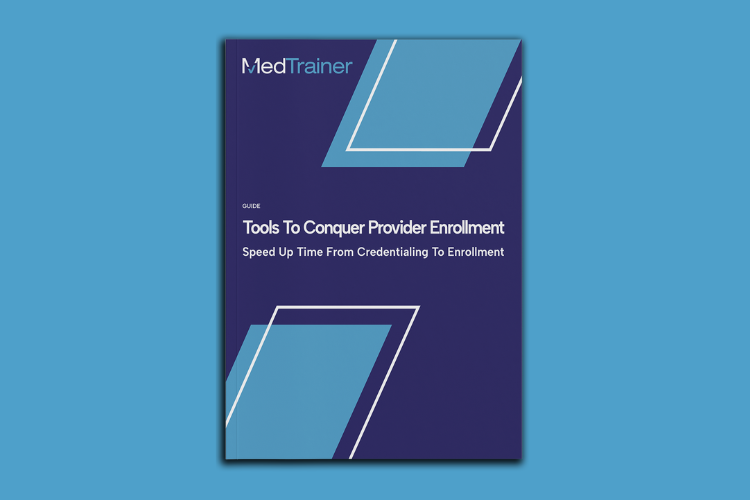Hundreds of required data points and dozens of documents make credentialing a tedious, time-consuming process. CAQH credentialing is a much needed time saver for nearly everyone involved. Sounds great, right? But, what is CAQH credentialing and how does it work?
In a nutshell, CAQH serves as a central hub where healthcare providers can submit and update all their professional information. This data is then readily accessible to participating health plans and networks, streamlining their verification process. In this blog post, we’ll demystify CAQH credentialing by answering some of the most commonly asked questions.
What Does CAQH Stand For?
CAQH stands for the Council for Affordable Quality Healthcare. Established as a non-profit alliance, CAQH aims to simplify healthcare business processes through collaboration and innovation amongst health plans, providers, and related organizations. CAQH has become a key player in the industry, focused on simplifying redundant tasks and reducing healthcare costs associated with administrative complexities.
CAQH ProView, now called the CAQH Provider Data Portal, simplifies the credentialing process for healthcare providers by offering a central location to manage and share their professional information with multiple organizations.
What Are the Benefits of CAQH for Credentialing?
One of the biggest challenges credentialers face today is the need to manage multiple systems and CAQH offers a glimmer of hope with its shared model. Here are some of the benefits you’ll experience:
First, having all confirmed data in one place. Instead of completing multiple, separate applications for each health plan or hospital, providers can fill out a single, unified application on the CAQH Provider Data Portal, which can then be accessed by multiple participating entities. Since providers are updating and completing CAQH attestation in one place, entities can be confident they have the most updated demographic and professional information.
Second, secure digital platforms enhance data accuracy and integrity. With information pulled directly from CAQH, there is less chance of someone misreading handwriting or making a data entry error. This not only minimizes errors but also reduces back-and-forth communications, further emphasizing efficiency. Choose credentialing software that offers this streamlined process.
Third, a quicker credentialing process is another substantial advantage. With traditional methods, waiting periods for credentialing can span several months, causing delays in partnering with new health plans or getting onboarded at new facilities. When providers are updating information in one location, with automatic population to other portals and softwares, approvals are quicker and patients can be seen sooner.

Get the tools you need to eliminate delays in your provider enrollment process.
What Information Is Required for CAQH ProView/CAQH Provider Data Portal?
CAQH collects the comprehensive provider data that credentialers need. The single source of truth and the ability to share this information throughout the credentialing process is a major win for credentialers and providers. Here’s a list of the information required to complete a CAQH provider application:
- Personal Details: This includes your full name, contact information, date of birth, and social security number.
- Educational History: Information about medical schools, degrees earned, graduation dates, postgraduate traning, residencies, and fellowships.
- Work History: A chronological record of your medical practice employment experience and any areas of specialization.
- Licenses & Certifications: Current and past medical licenses, DEA certifications, and other relevant certifications with details like issuing state, license number, and expiration date.
- Professional Liability Insurance: Information on your malpractice insurance, such as the coverage amounts, providers, and effective dates.
- Practice Locations: Addresses and details of your current and past practice locations.
- Hospital Affiliations: Information about hospitals you’re affiliated with or have admitting privileges.
- Board Certifications: Details on any board certifications that show areas of recognized expertise and commitment.
- Disciplinary Actions: A record of any disciplinary actions faced and rectifications to ensure transparency.
- Peer References: Names and contact details of professional peers who can vouch for your expertise and professional conduct.
How Often Is a CAQH Profile Updated?
The required updates to a provider’s CAQH profile give credentialers and payers confidence in the information. At a minimum, CAQH attestation must occur every 120 days. There are two scenarios that determine when a provider should make updates:
General CAQH Profile Update
It’s considered best practice to update the CAQH provider profile whenever there are significant changes in professional status. Whether it’s a new license, a change in practice location, or other notable event, promptly updating the CAQH profile ensures consistency and reliability for health plans and networks.
Required CAQH Credentialing – Re-Attestation
CAQH re-attestation is a requirement every 120 days, as regular updates ensure that any changes in practice, qualifications, or other relevant details are reflected. The recurring task helps to confirm that information is up to date and helps to maintain trust and transparency with health plans and other stakeholders.
Which Health Plans and Networks Participate in CAQH?
CAQH is recognized and accepted by a range of health plans and networks across the U.S. From major insurance carriers to regional health plans, the CAQH platform is widely used to streamline credentialing. Included are household names like Aetna, Blue Cross Blue Shield, Cigna, Humana, and UnitedHealthcare, among many others. Additionally, numerous managed care organizations and provider groups participate in CAQH, making it a centralized tool for the healthcare industry’s credentialing needs. The widespread use of CAQH by various health plans and networks emphasizes its value and efficacy in modernizing and simplifying administrative processes.
Do All Healthcare Providers Use CAQH Credentialing?
No, not all providers use CAQH. However, many providers find it convenient due to its centralized location and efficiency. The CAQH Provider Data Portal is a preferred tool by a number of health plans, hospitals, and credentialers, which makes it highly advantageous for providers who want to enroll or partner with these entities.
Simplify Your Credentialing Process With CAQH Management
CAQH credentialing certainly simplifies the process, but credentialing software built for enterprise organizations offers even more efficiency – combining streamlined CAQH data entry with a comprehensive provider profile, automation, and proven enrollment workflows. With credentialing software, you don’t even have to remember the provider’s CAQH attestation deadlines – the software will remind both you and the provider.
For growing healthcare organizations, it may still be too time intensive to complete credentialing, recredentialing, and ensure your providers are maintaining their CAQH profiles. A fully-managed credentialing service eliminates the strain entirely, offering white glove service to complete all aspects of credentialing, as well as CAQH profile management. Organizations with 50 or more providers may benefit the most from this service.
